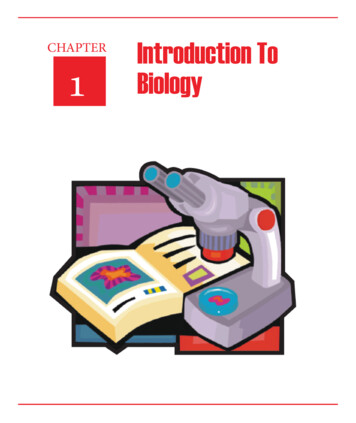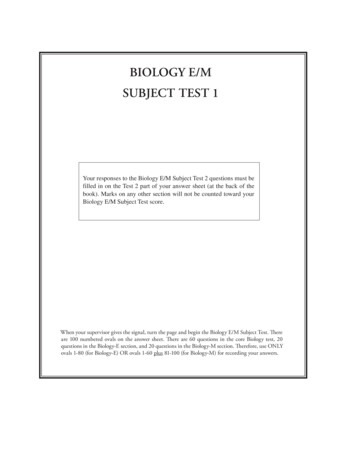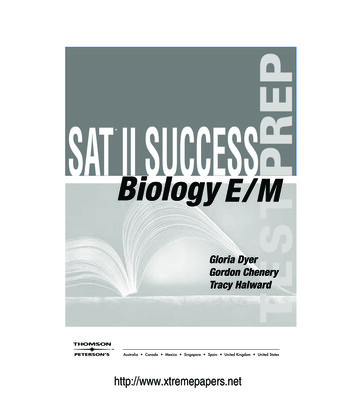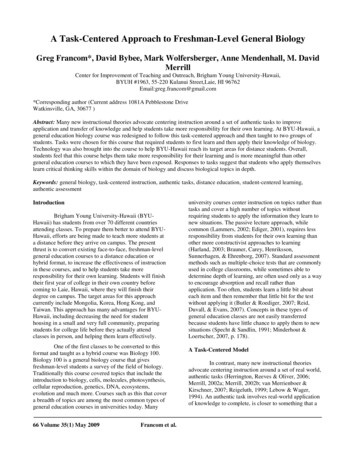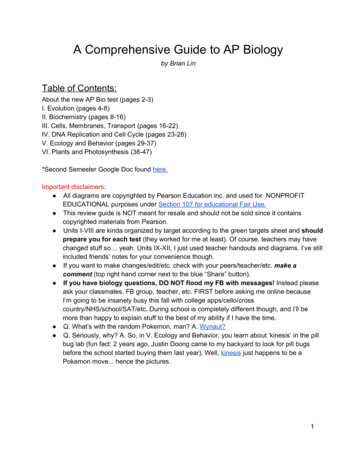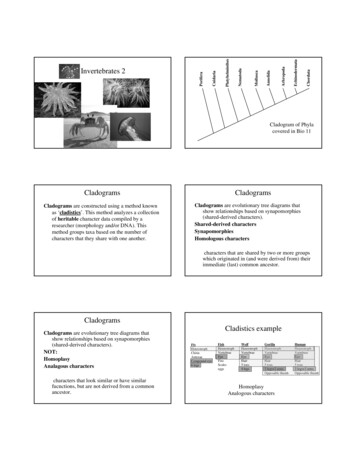
Transcription
todaPlatyhelminthesCnidariaPoriferaInvertebrates 2Cladogram of Phylacovered in Bio 11CladogramsCladograms are constructed using a method knownas ‘cladistics’. This method analyzes a collectionof heritable character data compiled by aresearcher (morphology and/or DNA). Thismethod groups taxa based on the number ofcharacters that they share with one another.CladogramsCladograms are evolutionary tree diagrams thatshow relationships based on synapomorphies(shared-derived characters).Shared-derived charactersSynapomorphiesHomologous characterscharacters that are shared by two or more groupswhich originated in (and were derived from) theirimmediate (last) common ancestor.CladogramsCladograms are evolutionary tree diagrams thatshow relationships based on synapomorphies(shared-derived characters).NOT:HomoplasyAnalagous characterscharacters that look similar or have similarfucnctions, but are not derived from a commonancestor.Cladistics exampleFlyHeterotrophChitinAntenaeCompound eye6 eterotrophVertebraeEyeHair5 toes4 legsGorillaHeterotrophVertebraeEyeHair5 toes2 legs 2 armsOpposable thumbHomoplasyAnalogous charactersHumanHeterotrophVertebraeEyeHair5 toes2 legs 2 armsOpposable thumb
Body Symmetry and CephalizationGeneral Characteristics1. Body Symmetry2. Cephalization3. Type of Gut4. Type of Body Cavity5. SegmentationRadial – body parts are Bilateral – right half and left halfare mirror images.arranged regularlyAnterior/Posterior – head/tailaround a central axis.(example: sea anemone) Dorsal/Ventral – back/stomachExamples of Body SymmetryRadialEchinoderm symmetryBilateralWhat about sea stars and seaurchins?As adults they have pentameralsymmetry which is a form ofradial symmetry, but theirlarvae show bilateralsymmetry and molecular dataindicates that their ancestorshad bilateral symmetry. Sowe consider them to bebilaterians.Types of GutsCephalizationSac-like GutBilateral organisms have developed a head inthe anterior (front) end. This may havebeen favorable when moving forward andbeing able to detect and eat what’s in frontof them. Many sensory and nerve cellshave become concentrated in the head.Tube-like GutMouthSingle opening foringesting food andexcreting wastes.AnusComplete gut with mouthand anus. Food travels oneway through the organism.
Types of Body Cavities in AnimalsTypes of Body Cavities in AnimalsCoelom Lined body cavityAcoel - no body cavityPseudocoel - unlinedbody cavitySegmentationRepeating series of body units that may bequite different.Examples:Segments of an earthworm are similar.Segments of a crustacean are different(lobster, insect).FossilsFossile evidence has provided a greart deal ofinformation about the origins of extanttaxa.
Ediacaran Fossils600600-542 million yearsAlso called “Vendian”Vendian”South AustraliaSprigginaEdiacara Hills, AustraliaDickensoniaBurgess ShaleEdiacaran Assemblage Yoho NationalPark Canadian Rockies 540 myaBurgess ShaleView from the QuarryWorking the Burgess ShaleHelena Walcott &family, ca. 1910?Charles Walcott inhis seventiesRoyal Ontario Museum camp, August2000, near Walcott’Walcott’s campsite
Burgess ShaleEdge of the QuarryDiscovery ofBurgess FossilsWalcott’Walcott’s Field NotesBurgess ShaleBurgess ShaleSlabs Ready to Split for FossilsPrepared Burgess FossilsTrilobiteFreshly Exposed FossilsBurgess lacarusArthropodAnnelidPolychaete wormFigure from: Starr, C. (2000). Biology, Concepts and Applications. Brooks/Cole.YohoiaMarellaOpabinia
Burgess AnimalsBurgess AnimalsWeird ArhropodaAnnelidaMolluscaCnidariaPoriferaThe Burgess SeaNematodaAysheaiaPlatyhelminthesPikaiaCladogram of Phylacovered in Bio 11Figure from: Starr, C. (2000). Biology, Concepts and Applications. Brooks/Cole.Origin of MulticellularityKey Points for Each Phylum: Recognize them Where they fall in the overall phylogenetic tree General Body Plan: symmetry, gut, coelom, skeletonAnimalschoanoflagellate-like protistsTwo hypotheses1. CiliatesOne cell, many nuclei2. Colonies General lifestyleColonies of cells that becamespecialized for certain tasks
thesCnidariaPoriferaRadialsymmetrySnails, Octopus, squid, clams,chitons, nudibranchs Bilateral symmetry many tissue types Organ symmetryNematodaRoundworms Bilateral symmetry Several tissue types Organ thesCnidariaNematodaBilateralsymmetryFlatworms Bilateral symmetry Tissues simplest organ nthesCnidariaPoriferaChordataEchinodermataJelly fish, corals, sea anemones Radial symmetry Simple tissues No thesCnidariaPoriferaSponges Basal to all animals no symmetry no tissues or organsBilateralsymmetrySegmented worms, Earthworm Bilateral symmetry Tissues Organ system
ChordataEchinodermataPorifera (Sponges)Success in Simplicity BilateralsymmetryNo symmetry, tissues, ororgansAbundant since Precambrian8000 species today“Filter” food from the waterSessile adultsSilica spicules General lifestyle: Marine filterfeedersMammals, reptiles, birds, fish Bilateral symmetry Complex Tissues Complex organ systemsPoriferaStructural Elements of SpongesA sponge releasing a cloud ofspermMost live in coastal, shallow watermarine environmentsSome deep ocean or fresh waterHermaphrodites that reproducesexually (most species)Sperm in water, but eggs retaineduntil fertilizedSwimming larval stageSpicule h, sea urchins, sea cucumbers Bilateral symmetry Tissues Organ thesCnidariaMolluscaBilateralsymmetryCrustaceans, Insects Bilateral symmetry Tissues Organ metry
Sponges – Skeletal ElementsSpongesVenus’s flower basket (Euplectella)Tethya aurantiapuffball spongeFigure 23.7 (c,d) frompage 361 of your textSpongesSpongesAcarnus erithacusred volcano spongeSpheciospongia confoederatamoon spongeSpongesSpongesCoral ReefSpheciospongia confoederata close-upmoon spongeVase Sponge
elly fish, corals, sea anemonesPhylum Cnidaria – anemones,corals, jellies1. Key Innovations are radial symmetry anda tissue-level of organization (still no organs)2. Diploblastic – have only two embryonic tissues(ectoderm and endoderm)3. Have a sac-like gut4. Two body forms – polyp and medusapolyp is sessile and benthic, medusa is planktonic5. Carnivores with one gut opening6. Reproduce sexually and asexually (budding)Cnidarian ReproductionCnidarian Body Formsreproductive polypfemale medusaovumone branchpolypfrom a mature branching formingcolonymedusaCnidariansPhylum CnidariaCnidocytesCells containinga lyppolypmale medusaHollow threadDelivers venomTrigger(cnidocil)Barbed tubenematocystCnidocyte (cell)Sea wasp warningsea wasp warningplanula
CnidariansCnidarians - cnidocystshydroidJellyfish stingsCnidariansCnidariansLytocarpus philippinusstinging hydroidMillepora – fire coralCnidariansCnidariansPortuguese Man O’ War(Physalia physalis)Millepora – fire coral close-up
CnidariansCnidariansclose-up of tentacles ofPortuguese Man O’ War(Physalia physalis)Urticina lofotensisrose colored orals from the Great Barrier ReefCnidariansCnidariansTubastreatropical coralcup coral close-up
CnidariansCnidarianssymbiotic zooxanthellae(dinoflagellate) in coral tentacleEchinophyllia aspera(gray coral) close-upCnidariansCnidarianssoft coralgorgonian(sea fan)CnidariansCnidariansgorgonian close-up (sea fan)gorgonians (sea fans)noticepolyps
CnidariansCnidariansChrysaora fuscescensSea nettle jellyChrysaora fuscescenssea nettle jellyCnidariansCnidariansChrysaora (Pelagia) colorataPurple-striped jellyExam on Friday!We will have fewer questions!Review session tonight at 5:30 in 2301 Tolman.Chironex fleckerisea wasp
Starfish, sea urchins, sea cucumbers Bilateral symmetry Porifera Cnidaria Platyhelminthes Nematoda Mollusca Annelida Arhropoda Echinodermata Chordata Bilateral symmetry Complex Tissues Complex organ systems Mammals, reptiles, birds, fish Bilateral symmetry Porifera (Sponges) Success in Simplicity No symmetry, tissues, or organs

